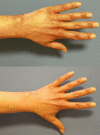Medical Needling: Effect on Moisture and Transepidermal Water Loss of Mature Hypertrophic Burn Scars
- PMID: 29805934
- PMCID: PMC5969801
- DOI: 10.7759/cureus.2365
Medical Needling: Effect on Moisture and Transepidermal Water Loss of Mature Hypertrophic Burn Scars
Abstract
Background: Burn scars remain a serious psychological and physiological problem for affected people. Clinical studies and scientific research have already shown that medical needling improves the scar quality in terms of skin elasticity and erythema. At the same time, patients are confronted with a low-risk therapy and face comparatively less postoperative complications.
Objective: The goal of our study was to examine the influence of medical needling on the skin moisture and transepidermal water loss (TEWL) of hypertrophic dry scars. Therefore, 20 patients, of an average age of 34.63 years, with deep second- and third-degree burn scars have been treated.
Methods: Medical needling is performed using a roller covered with needles of 3-mm length. The needling device is rolled over the scar in three directions: vertically, horizontally, and diagonally in order to create as many puncture channels as possible. The puncturing leads to multiple micro-wounds and intradermal bleeding, which evokes the post-needling regeneration cascade. The patients were followed up for 12 months postoperatively. The results have been evaluated by means of objective as well as subjective measurement methods.
Results: The objective measures show that medical needling influences epidermal thickness and improves the epidermal barrier function at a molecular level. Outcomes are marked by a measurable increase in skin moisture and a reduction in TEWL.
Conclusion: Medical needling seems to be a promising approach for the treatment of mature hypertrophic burn scars with a focus on skin moisture and TEWL.
Keywords: barrier function; hydration; low-risk therapy; minimal invasive technique; moisture; transepidermal water loss.
Conflict of interest statement
The authors have declared that no competing interests exist.
Figures
















Similar articles
-
[Medical Needling: effect on skin tension and elasticity of hypertrophic burn scars].Handchir Mikrochir Plast Chir. 2019 Sep;51(5):384-393. doi: 10.1055/a-0996-8572. Epub 2019 Oct 1. Handchir Mikrochir Plast Chir. 2019. PMID: 31574553 German.
-
Medical Needling: Effect on Skin Erythema of Hypertrophic Burn Scars.Cureus. 2018 Sep 6;10(9):e3260. doi: 10.7759/cureus.3260. Cureus. 2018. PMID: 30430049 Free PMC article.
-
Combination of medical needling and non-cultured autologous skin cell transplantation (ReNovaCell) for repigmentation of hypopigmented burn scars.Burns. 2016 Nov;42(7):1556-1566. doi: 10.1016/j.burns.2016.04.009. Epub 2016 May 4. Burns. 2016. PMID: 27156803 Clinical Trial.
-
Percutaneous collagen induction (microneedling) for the management of non-atrophic scars: literature review.Scars Burn Heal. 2019 Nov 26;5:2059513119880301. doi: 10.1177/2059513119880301. eCollection 2019 Jan-Dec. Scars Burn Heal. 2019. PMID: 31807320 Free PMC article. Review.
-
[Acne scars and striae distensae: Effective treatment with medical skin needling].Hautarzt. 2015 Oct;66(10):748-52. doi: 10.1007/s00105-015-3662-5. Hautarzt. 2015. PMID: 26251169 Review. German.
Cited by
-
Microneedling for the Treatment of Scars: An Update for Clinicians.Clin Cosmet Investig Dermatol. 2020 Dec 22;13:997-1003. doi: 10.2147/CCID.S267192. eCollection 2020. Clin Cosmet Investig Dermatol. 2020. PMID: 33376377 Free PMC article. Review.
-
A bioactive three-layered skin substitute based on ECM components effectively promotes skin wound healing and regeneration.Mater Today Bio. 2025 Feb 20;31:101592. doi: 10.1016/j.mtbio.2025.101592. eCollection 2025 Apr. Mater Today Bio. 2025. PMID: 40092225 Free PMC article.
-
Evaluating the Irritant Factors of Silicone and Hydrocolloid Skin Contact Adhesives Using Trans-Epidermal Water Loss, Protein Stripping, Erythema, and Ease of Removal.ACS Appl Bio Mater. 2024 Jan 15;7(1):284-296. doi: 10.1021/acsabm.3c00874. Epub 2023 Dec 27. ACS Appl Bio Mater. 2024. PMID: 38150300 Free PMC article.
-
The Current Status of Clinical Research Involving Microneedles: A Systematic Review.Pharmaceutics. 2020 Nov 19;12(11):1113. doi: 10.3390/pharmaceutics12111113. Pharmaceutics. 2020. PMID: 33228098 Free PMC article. Review.
-
[Transepidermal water loss of scar skin in three types of scar patients and its correlation with scar severity].Zhonghua Shao Shang Za Zhi. 2021 Jul 20;37(7):629-634. doi: 10.3760/cma.j.cn501120-20200310-00145. Zhonghua Shao Shang Za Zhi. 2021. PMID: 34139828 Free PMC article. Chinese.
References
-
- Epidemiology of burns throughout the world. Part II: Intentional burns in adults. Peck MD. Burns. 2012;38:630–637. - PubMed
-
- The problem scar. Su CW, Alizadeh K, Boddie A, Lee RC. https://www.ncbi.nlm.nih.gov/pubmed/9696905. Clin Plast Surg. 1998;25:451–465. - PubMed
-
- Update on pruritic mechanisms of hypertrophic scars in postburn patients: the potential role of opioids and their receptors. Cheng B, Liu HW, Fu XB. J Burn Care Res. 2011;32:118–125. - PubMed
-
- Number of cell layers of the stratum corneum in normal skin - relationship to the anatomical location on the body, age, sex and physical parameters. Ya-Xian Z, Suetake T, Tagami H. https://www.ncbi.nlm.nih.gov/pubmed/10552214. Arch Dermatol Res. 1999;291:555–559. - PubMed
-
- Reliability of repeated measurements on post-burn scars with Corneometer CM 825®. Anthonissen M, Daly D, Peeters R, et al. Skin Res Technol. 2015;21:302–312. - PubMed
LinkOut - more resources
Full Text Sources
Other Literature Sources
